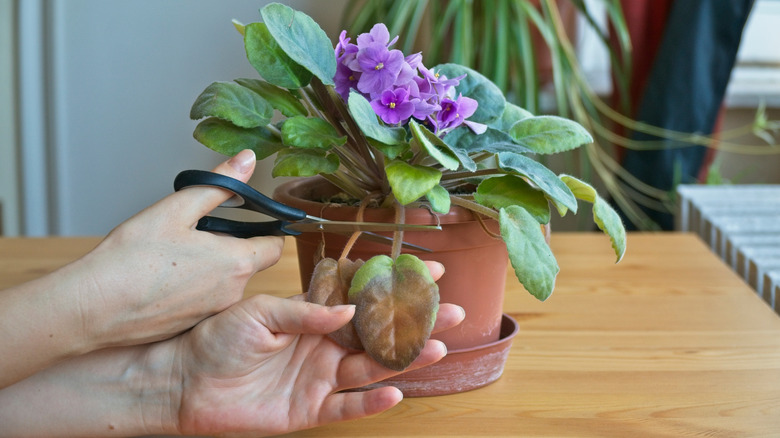How To Care For African Violets In Winter So They Continue To Thrive
For some, winter can be a depressing time of year. With cold, dreary weather, shorter days, and less opportunity to spend time outside, it's easy to become gloomy. That's one of the reasons many people like to have houseplants in their homes. One of the most popular houseplants that can bring a little bit of color and cheer during long winter nights is the African violet (Saintpaulia ionantha). This adorable little plant, with its bright purple blossoms and fuzzy leaves, is perfect for those who don't mind a houseplant that can be a little picky. Once you get to know your African violet and what it likes, it can bless you with flowers year-round. With light trimming, the right amount of light, and careful watering, you can successfully grow and care for African violets in winter.
In the U.S., African violets exploded in popularity in the late 1920s. They're popular houseplants to this day, most likely due to their low-maintenance nature and attractive appearance. They can thrive under grow lights, which makes them ideal for almost any room in the house. Although they are vulnerable to certain diseases and pests, with a little effort, you can keep these issues from affecting your little plants. There are also some simple ways to quickly deal with problems that are likely to happen in the winter, like treating powdery mildew before it becomes too much of a concern.
Tips to help your African violet thrive through winter
One of the biggest mistakes people make with African violets is overwatering. Not just overwatering, but watering with water that is too cold. The best way to water an African violet is to use the wick method (i.e. via a candle wick or twine) or by watering from the bottom up. Never let your plant sit in a waterlogged potting medium — this can cause rot. Also, in the winter, the air in most homes tends to be too dry for an African violet. The best way to combat this issue is to place your plants in a tray lined with gravel with a small amount of room temperature water in the bottom.
Winter is a good time to trim any wilted or dying leaves off your African violet — this step will help it channel more energy into blooming. Another big winter tip for a thriving plant is to make sure it gets the appropriate amount (and the right type) of sunlight. African violets need at least eight hours of indirect bright sunlight a day. In winter, it can be harder to maintain this amount of light because the days are shorter. Thankfully, these cute plants do well under fluorescent or LED lights. If you need to supplement with artificial light, just be sure your plants also get at least 8 hours of darkness each day and keep the light at least 10 inches above your plants. These tips will help encourage more beautiful blooms and keep your African violet thriving through the winter months.

